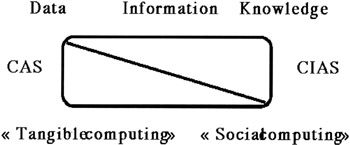4 Conclusion
4 Conclusion
For accounting for context in communicating objects, one must have: (1) an access to a base of data/information/knowledge updated practically in real time, (2) a formalism for a context-based representation of the data, the information, the knowledge, and a user 's model, (3) an efficient combination of the " tangible computing" and the "social computing", and (4) modelling of the user in real time from his actions during his interaction with the system. Indeed, as it was said in artificial intelligence several years ago, a communicating object must be something between a reactive object (i.e. reacting only to user's interventions) and a strongly active object by guiding the user among the possible alternatives.
In this chapter, we present two approaches, a "social computing" approach in which are ascribed our works in the framework of the context-based intelligent assistant systems (CIAS), and a "tangible computing" approach in which are supposed to evolve communicating objects and context-aware systems (CAS). Both approaches have particular viewpoints in the context, mainly in relation with the fact that the CASs are concerned with data, and the CIASs are concerned with the knowledge.
As shown in Figure 21.5, which presents a unified view of the two approaches, the main challenge is a joint effort of both communities to design and develop communicating objects. This position is close to Dourish's position (2001) with his concept of embodiment to merge "tangible computing" and "social computing".

Figure 21.5: Respective positions of CAS and CIAS with respect to data, information and knowledge
EAN: 2147483647
Pages: 191